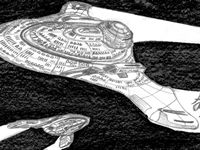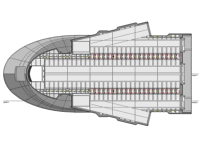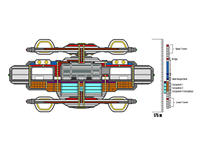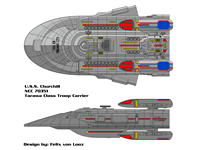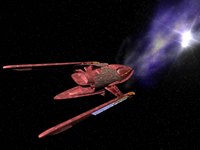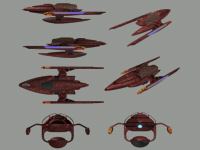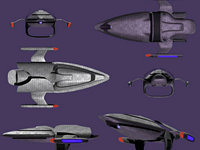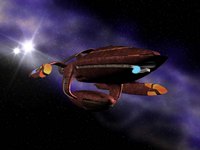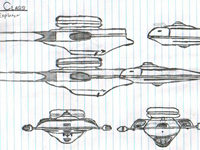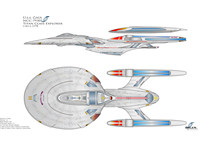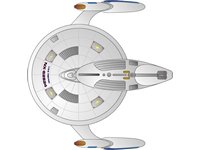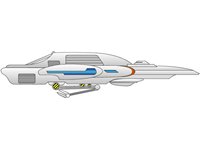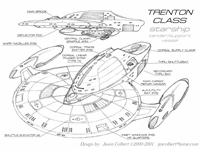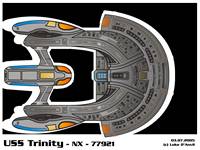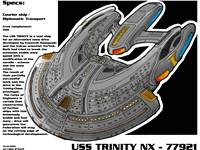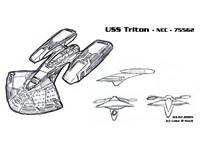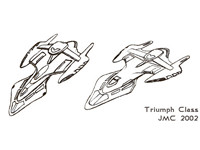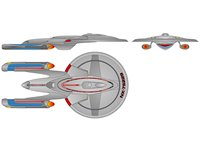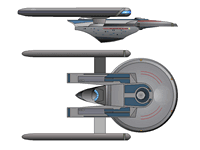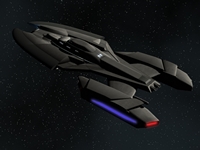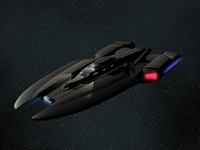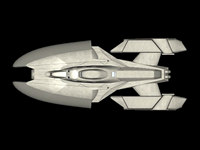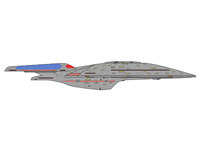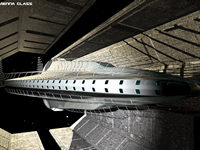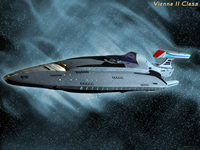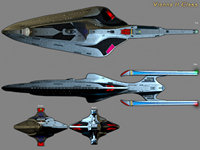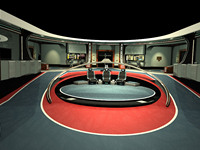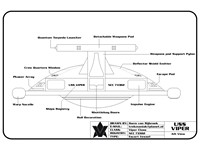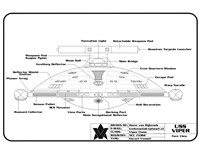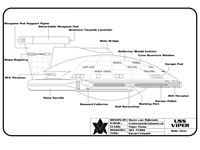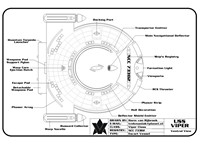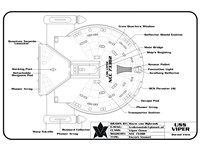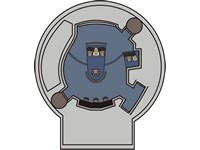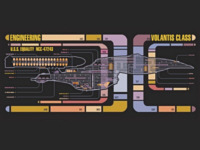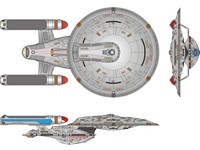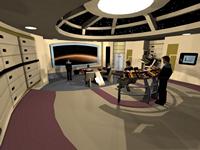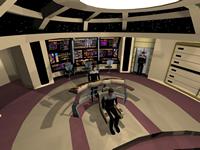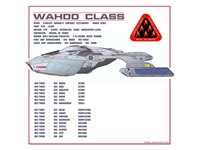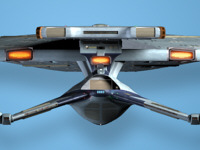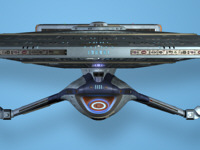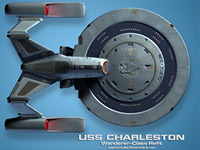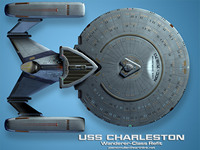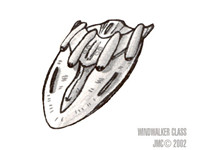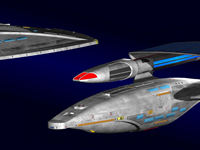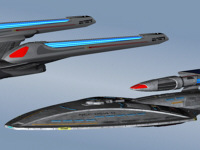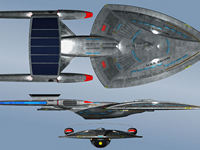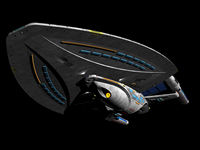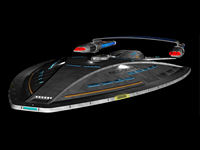Starships T-Z
Starships, Starships A-B, C-E, F-H, I-L, M-N, O-Q, R-S, T-Z, Space Stations
Takahashi Class
Design by Saint AJ
Type: Intercept/patrol cruiser
Length: 480m
Beam: 461m
Height: 103m
Displacement: 2,400,600 tonnes operational
Crew: 430 (71 officers, 359 enlisted/nonrated)
Passenger capacity (in staterooms): 80
Evacuation limit (including cargo areas and staterooms): standard crew +
1200
Embarked craft: provision for up to 20 shuttlecraft or 12 shuttlecraft and 4 runabouts or fighters, 190 Model IV ASRV lifeboats
Propulsion
Superluminal:
Standard cruise speed: Warp Factor 7 (1.967 x 10^11 meters/second)
Maximum safe speed: Warp Factor 9.9 (9.153 x 10^11 meters/second)
Emergency maximum speed: Warp Factor 9.96 (1.885 x 10^12 meters/second) for no more than 12 hours
Sublight:
Time to from zero velocity to full impulse: 36 seconds
Time from full impulse to zero velocity (standard reverse power only): 72 seconds
Main propulsion: 2x custom-fitted double warp coil assemblies (in port and starboard hull extensions)
Sublight propulsion: 8x impulse driver coil assemblies (one pair in port/starboard hull extensions, two pairs in rear of primary hull)
Sublight maneuvering: 8x reaction jet clusters
Power plant:
Main power: 1x Class 9F matter/antimatter reactor
Secondary power: 16x impulse fusion reactors
Auxiliary power: 9 auxiliary micro-fusion generators
Flight/environmental control:
Main computer: multiple bio-neural gel pack computer system
Auxiliary computer: shielded isolinear flight control computer
Tactical
Energy weapons:
12x Type 9 collimated phaser arrays (1 array on dorsal saucer, 2 arrays on ventral saucer, 3 arrays on secondary hull, 2 arrays on each hull extension, 2 arrays on Bussard hydrogen collector modules)
2x Type 12(P) pulse phaser cannon (forward swiveling mounts in upper recessed weapon bays)
4x Type 9 single-emitter phaser banks (forward mounts in upper and lower recessed weapon bays)
Projectile weapons:
1x Mark VI sustained-fire variable-warhead torpedo launcher turret (forward, upper secondary hull dome)
4x Mark VI five-shot burst variable-warhead torpedo launchers (forward, paired in lower recessed weapon bays)
2x Mark VI three-shot burst variable-warhead torpedo launchers (aft, in port/starboard weapon bay fairings)
Ammunition magazines: (760 torpedoes total)
240 Mark VI torpedo devices in upper magazine feeding turret
400 Mark VI torpedo devices in saucer, feeding forward launchers
60 Mark VI torpedo devices in port and starboard weapon bay fairings, feeding aft launchers
(standard load of 60% enhanced photon torpedoes, 30% quantum torpedoes, 10% warp probes and specialized munitions)
Defensive systems: adaptive multiphasic shield grid, rated at 2,000,000 terajoules, ablative armor coating, average thickness 5cm
Ships of the line
- USS Takahashi NCC-77361 - active
- USS Watanabe NCC-77362 - active
- USS Yatate NCC-77363 - undergoing space trials
- USS Chung NCC-77364 - final construction phase
- USS Otamo NCC-77365 - under construction, est. completion in 6 months
- USS Nobumoto NCC-77366 - under construction, est. completion in 6 months
History
Designed as a rapid-response and pursuit vessel, the Takahashi-class starship is targeted at smuggling cartels and pirates operating in distant corners of the Federation. Its weapons array and engines are geared toward fighting at warp speed, a necessity now that many criminals have access to illegally-obtained weapons and warp drives. In many cases these blockade runners are fast enough to evade all but the newest Starfleet vessels. In addition, a powerful array of pulse and beam phasers allows the Takahashi to cut through even the strongest shields available on the black market. This combination of weaponry and a maximum speed in excess of warp 9.9 makes the Takahashi a potent warship as well. The first two ships of the class, the Takahashi and Watanabe, have already earned names for themselves by putting an end to a weapons smuggler whose exceptionally fast craft were transporting trilithium warheads. Four more Takahashis are being built to supplement existing system defense forces throughout the Federation. In lieu of producing more of the resource-intensive Sovereigns to fill a role for which they were not designed, Starfleet may build additional Takahashis after the initial six to serve as guardians for the Federation's vast interior.
Tarawa Class
Design by Felix von Looz
Type: Troop carrier
First commissioned: 2373
Length: 641m
Width: 342m
Height: 175m
Decks: 36
Complement: 5000 officers + 300 crew, evacuation limit: 10000
Speed: Warp 9.9 (cruise), Warp 9.99 (max.), Warp 9.99 (max. emergency)
Armament: 28 Type-X phaser arrays, 4 quantum torpedo launchers, 8 torpedo/phaser towers
Defense: standard shields + 5 extra hangar-atmospheric-shields in the hangar gates
Embarked craft: 100 type-4
The Tarawa-Class Carrier is a tactical ship, constructed in the early 2370's to transport troops and tactical shuttles into a battle zone quickly. There are 3 huge hangars in the rear part of the ship and one smaller one in the front part. At all there are 8 hangar gates. In the largest hangar in the middle there is space enough for 100 hoppers. To control and protect shuttle start and landing operations, there are two heavy-armed Towers over and beyond the huge rear hangar gates. To lead the arriving shuttles into the hangars, there are 18 small tractor beam emitters around the hangar gates and another 10 in the hangars. Beyond the hangars there are 3 cargodecks with a capacity of 200000m3. The third cargodeck is a cargobay, a hangar for cargoshuttles. Under and next to this cargodecks and in the front part of the ship, there are quarters for the tactical officers, other tactical personnel (soldiers) and the crew members. Although the ship is heavily armed, it's nevertheless vulnerable in the moment when the hoppers are leaving the hangars through the rear hangar gates. Because of this troop carriers are usually escorted by another combat vessels. Additional to the 100 hoppers and other shuttles, there are 52 escape pods, to leave the ship in a case of emergency. The Troop Carrier is the second ship class (after the Defiant), constructed for tactical use only. The prototype, the NX Tarawa left the shipyard in 2373. 2 years later 12 Tarawa class carriers have been used in the Dominion War to bring hoppers and troops into the orbit of hard-fought planets.
Thresher Class
Design by Kenny, ASDB Member
No specs available
During the development, the Thresher turned out to be a Vulcan vessel.
Tiron Class
Design by Sean
Type: Deep space explorer
Length: 523m (total), 189m (saucer section), 334m (stardrive section)
Beam: 157m (saucer section), 182m (stardrive section)
Height: 78m
Decks: 17
Max. speed: Warp 7.566 (saucer section), Warp 9.975 (stardrive section)
Mass: 2,703,200t
Crew complement: 23 officers, 186 crew, 2450 max.
The Tiron class starship has a unique saucer section. The saucer has two warp nacelles that are hidden in side two large bumps on the aft part. This ship was designed by a team of Utopia Planitia engineers to assist the Nebula and Galaxy classes in their exploration roles. With the abundance of old space frames around they decided to create a starship using up some of the frames and making a completely new starship. Two years in the design phase the Dominion was started and they redesigned the weapons systems. One year into the war the U.S.S. Tiron was completed in a rush. The ship looked like one of the old Excelsior Variants with a weapons pack on top. That ship was not put in to combat because of many design flaws. Four years after being started at Utopia Planitia the ship finally was commissioned under command of Captain Thomas Frail. Three more of the class were proposed to be built, but so far there is only the Tiron out there.
Titan Class
Design by Galen
Type: Explorer
Length: 770m
Decks: 25
Max. warp: Warp 9.98
Cruising warp: Warp 7.5
Could the ship that Will Riker took command of in "Nemesis" look like this?
Trenton Class
Design by Jason, ASDB Member
2D drawing by Kris, ASDB Member
Type: Tender/support vessel
No description
Trinity Class
Design by Luke D'Anvil
Type: Courier ship / diplomatic transport
First commissioned: 2384
Length: 450m
Width: 300m
Height: 88m
Decks: 22
Displacement: 3500000t
Complement: 50 officers + 450 crew, evacuation limit: 950
Speed: Warp 9.5 (cruise), Warp 9.8 (max.), Warp 9.95 (max. emergency)
The construction of the Trinity-Class is a concession of Starfleet to the Dominion War. During the conflict the Federation realized that they needed every ally they could get. The main problem was that the fleet often had only sufficient defense capabilities at their disposal in order to bring high-ranking diplomats to important political functions of the Alliance. While ships of the Galaxy-Class were more needed in the combat zone, Sabre-Class ships were simply too poorly defended and too slow.
Starfleet decided to explore a theory of the engineer Ivanovah Kassynski and the Vulcan scientist Tro'Vek. Both had tried to break the maximum stable warp speed with a modification of the nacelle-scheme and the warp cores. The result of their partially successful work was the drive in the Trinity-Class prototype. After the primary warp core was installed and the first EPS tests were passed successfully, the Corps permitted the installation of the two secondary cores. The rate of the total energy output confronted the engineers with the problem of unstable plasma lines. The planning office strengthened the lines and introduced some distributor knots into the system. Further tests after that were successful. The armor was set up to 90 percent and a first interstellar flight at low speed was set to go. The start-up of the center, double-chambered warp nacelle guaranteed the necessary stability of a high speed warp field. If the nacelle is inactive, the Trinity must fall back to conventional speeds. A side effect of the triple core construction is the high energy output of the weapons systems. The ship, although armed conventionally, is able to generate massive phaser output and thus guarantees the security of the diplomats or important freight aboard. The shuttlebay is located at the front. It separates the two main VIP-areas. The Corps of Engineers installed eight phaser-stripe; four on top, four underneath. In addition four torpedo tubes were installed; one in each aft-pylon and two in the saucer.
It's a pity that the Trinity was introduced after the end of the Dominion War. It is momentarily at an unknown point in it's development. The Corps of Engineers is certain that construction of further ships with this immensely stable and fast warp-drive will guarantee the Federation will stay on the cutting edge of technological development.
Text revised by SCN-Mod "Bond, James Bond"
Triton Class (2)
Design by Luke D'Anvil
Type: Armoured multitask ship
First commissioned: 2368
Length: 280m
Width: 160m
Height: 88m
Decks: 21
Displacement: 2500000t
Complement: 30 officers + 150 crew, evacuation limit: 450
Speed: Warp 9.3 (cruise), Warp 9.6 (max.), Warp 9.75 (max. emergency)
The USS Triton is the first ship class in the fleet which is equipped with the V2 Ablative Armour in series. The prototype of the heavily armored research ship is missed since an investigation of a nebula near Xilon Theta four. Latest and last sensor data are showing an enormous energy impact, shortly after that ship and nebula had suddenly disappeared under strange circumstances. An emergency force is still scanning near systems without any results. Amendment Klingon long-range-sensors had sensor contact to the USS Triton five weeks ago far at the end of the Beta quadrant. On requests of the Fleet chancellor Martok and the High Council sent a taskforce with three ships for a search & rescue mission. First subspace transmissions forebode that the ship is almost intact, adrift and without crew.
Triumph Class
Design by Jason, ASDB Member
No specs available
No description
Tsien Class
Design by Kris, ASDB Member
No specs available
No description
Unnamed Class
Design by Ryan, ASDB Member
No specs available
This is an attempt to design an Excelsior-era ship with the appeal of the "Akiraprise".
Valkyrie Class
Design by
Rian
Type: Heavy scout
Length: 110m
Height: 18m
Decks: 4
This class has similar fire power and performance as the Defiant-class ships but is put in a smaller and more maneuverable frame.
Venture Class
Design by Novice, back story by USS Paladin
Type: Explorer / heavy cruiser
Commissioned: 2382
Length: 437.4m
Height: 65.7m
Width: approx. 150m
Decks: 18
Crew: 250
Normal Cruise: Warp Factor 8
Maximum Cruise: Warp Factor 9.9
Maximum Rated: Warp Factor 9.99 (for thirty-six hours)
Armament: 3 x Type-XII Phaser Arrays (belly and forward dorsal arrays), 12 x Type-X Phaser Arrays, 4 x Burst Fire Quantum Torpedo Tubes, + 400 Torpedoes, 1 x Rapid Fire Quantum Torpedo Turret, + 150 Torpedoes (under saucer)
Defensive systems: High Capacity Auto Modulating Regenerative Shield System, 20cm Ablative Armour
If the heavy casualties of the Dominion War proved one thing, it was that a new breed of starships was needed.
Project Thunderfoot was born of this need. It combined the firepower and resilience of the Akira with the swiftness and exploratory capabilities of the Intrepid, into a highly potent mid-size vessel, capable of eventually replacing both previously mentioned ships. The six competing designs varied from a catamaran hull to a tucked in, Defiant style ship, but ultimately, the sharp angled fusion of Intrepid and Sovereign styling cues, Starfleet Design Study 9664-Alpha, was chosen. The selection was officially announced in 2379, and construction of the prototype began late that same year. Full production began in 2383, with a quota of 36 vessels to be filled each year through production by both Utopia Planitia and Beta Antares shipyards.
The prototype was completed three years later, in 2382, despite problems with the structural integrity field and internal bulkheads: the durable, thick ablative armor coating gave the vessel significantly higher mass than other ships of its size. The warp pylons were reinforced with heavy tritanium beams, as were several key points in the saucer and engineering section.
Warp performance is provided by two AEVn-3 units (Advanced Environmental/Velocity nacelle 3), which can propel the Venture to a top speed of Warp 9.99 for a day and a half, a maximum cruise of an astounding Warp 9.9, and a normal cruise of Warp 8; the Venture is the ideal ship for rapid response to crises or emergency situations.
One of the key features of the design, and reasons it defeated its competitors, was its modularity. The engine room has been enhanced in size, structural strength, and power relays, and is capable of handling a Quantum Slipstream drive, if such technology is made available for future refits. Hardpoints on the hull can be fitted with Ablative armor generators, extra escape pods or airlocks, or a myriad collection of other systems. The Warp core and fusion reactors can also be retooled to produce a higher than needed output to accept these new systems.
Defense is provided by a high capacity regenerative shielding system, coupled with 20cm of ablative armor generators. The Venture packs a hefty punch, featuring a Quantum torpedo turret and four burst fire launchers (2 fore, 2 aft), along with 15 phaser arrays, 3 Type-XII units and 12 Type-X units, capable of covering a full 360 degrees around the vessel. Such coverage is nearly unheard of in a midsize vessel, and is far superior to competing Klingon and Romulan designs.
With a powerful punch, excellent speed and agility, and unmatched versatility, the Venture-class is sure to be one of the mainstays of the fleet for years to come.
Vienna Class
Design by Clawhammer
Type: Explorer
Year of completion: 2374
Length: 780m
Width: 199m
Height: 114m (from hull), 143m (from warp drive to warp drive)
Weight: 396,095mt
Cargo capacity: 24,500mt
Deck count: 30
Crew complement: 162 officers, 525 enlisted crew, 221 civilian/family, 4500 total emergency capacity
Speed: Warp 6.2 (cruise), Warp 9.2 (max. cruise), Warp 9.912 (in theory)
Tactical systems: 16 Phaser strips Type-12, 4 forward torpedo launchers, 4 backward torpedo launchers, 150 photon torpedoes, 150 quantum torpedoes
Shuttlebays: 2 shuttlebays, 1 captain's yacht bay
Current ship in the class:
- U.S.S. Reinksbergen (NCC-77211)
Planned ships in this class:
- U.S.S. Draykon (NCC- 77217)
- U.S.S. Grindelwald (S31 Variant)
The main purpose of this vessel is space exploration, because of the luxury interior it also is a perfect platform for a diplomatic mission. A key difference between most other Starfleet ships and the Vienna is the position of the nacelles, they are arranged vertically like on the Challenger. The advantage of this setup is the that the ship is more maneuverable. Instead of using one big deflector the Vienna II- class uses two smaller deflectors on the top and bottom of the ship. This is an experimental element, the Intrepid class already used an auxiliary deflector, this is one step further in that evolution. The Vienna II class can use almost any (Starfleet) warp core available. An entire drive can be swapped in 7 hours (2 hours of testing and calibrating).
The original U.S.S. Vienna (NX-1778) was designed by Peter Weaver in 2290, he also did 2 science variants of this ship. The Vienna II is a homage to its predecessor.
Viper Class
Design by Harm van Rijbroek
Type: Escort vessel
Unit run: 3 commissioned + 5 units in production
Commissioned: 2373-present
Length: 116 m
Beam: 112 m
Height: 42 m
Decks: 14 (including weapons pod)
Mass: 200,000 tons
Crew complement: 165
Weapons: 11x Type-X phaser array, total output 40,000 terawatts, 6x pulse fire quantum torpedo tubes + 700 torpedoes
Defence systems: shield system, total capacity 2,000,000 terajoules, heavy duranium/tritanium hull + 10cm high density armour, high level structural integrity field
Speed: Warp 7 (normal cruise); Warp 9 (max. cruise); Warp 9.6 (max. rated for 12 hours)
Diplomatic capability: Grade 2
Expected hull life: 30 years
Refit cycle: 7 months (minor), 1 year (std.), 15 years (major)
The Viper class idea was conceived after the Borg incident in 2366. Starfleet gave Utopia Planitia the order to design several different designs which could be used against the Borg. After several months of designing Utopia Planitia came up with a number of designs, including the Defiant class and the Viper class. Starfleet decided to put them both in production.
The first ship, the USS Viper NCC-73382, had a lot of problems during construction, it took over two years before the USS Viper was completed. This was because of several problems. The warp core exploded two times after being installed into the ship, thus the ships had to be virtually rebuilt two times, the ship was also severely damaged after an attack of the Maquis. Because of these problems the USS Viper could not be launched until 2 weeks after the Borg Incursion in 2373. But the ship would soon see much action when the Dominion War began. In the wake of the Dominion attack Starfleet ordered two more Viper class ships, the USS Cobra NCC-73383 and the USS Python NCC- 73384. All three ships served as front-line ships during the war. One memorable victory involving a Viper class ship, the USS Viper, when several vessels war engaged in a battle with a Jem'Hadar Dreadnought, the USS Viper got caught in a tractor beam from the Dreadnought. Unwilling to surrender the captain decided to detach the weapons pod and send it as a "gift" to the Dreadnought, when the Dreadnought pulled the weapons pod in with a second tractor beam, the USS Viper remotely detonated all 700 torpedoes stored inside the pod, resulting in the destruction of the Jem'Hadar vessel, but also severely damaging the USS Viper and the surrounding ships. The USS Viper spent six months in drydock after this action. After the war was over Starfleet ordered five more Viper Class vessels, which are currently in production.
The Viper class ship is a very compact design, thus resulting in high maneuverability. This ship has one unique feature: a detachable weapons pod, in this pod are six pulse fire quantum torpedo tubes and it is packed with 700 torpedoes. The idea was that after a ship had used up its torpedoes it would return to a drydock and the entire pod would be replaced with a new loaded one, the replacing of a pod could be done as fast as 15 minutes. The maximum warp of the Viper Class is only Warp 9, it was meant to go as fast as Warp 9.8 but after testing the warp core got instable and since the engineers could not fix the problem the maximum warp was tuned down to Warp 9.
Volantis Class
Design by T. Junk, history by Red Austin
Length: 453.75m
Width: 256.23m
Height: 86.76m
The Volantis-class project was started in 2352 because of a need to replace aging and destroyed Ambassador class ships in the exploration and defensive areas of Starfleet. The requirements were that it should be smaller than the Ambassador class to keep costs down, have a top speed of warp 9.6 to compete with the planned Galaxy class, have weapons which would be have significantly improved over the Ambassador class, and to have the premier guest accommodations.
Over 20 designs were submitted to be this class. The ASDB narrowed it to 7, one of which was to be later modified and augmented to be the Schneider-class frigate. A Blue Star Engineering committee performed simulated warp performance tests and was narrowed to three finalists. Another design was dropped due to problems concerning room for vital equipment. The last design was dropped after simulated warp stress test failed to perform the required speed of Warp 9.6. for 12 hours. The specifications were laid down at a length of 475.90 meters, a height of 86.76 meters, and a width of 256.23 meters. The ASDB shortened the class to 453.75 m. with no loss.
During May 2356 the keel was laid down at Rigel Fleet Construction Yards under command of Commander Keogh, who would later command the USS Odyssey. After initial problems of slow construction due to delays caused by the need for parts the USS Galaxy, Commander Keogh was promoted to Captain and given command of Challenger-class USS Kearsage and Commander Quinteros assumed control of the yards. Quinteros diverted the limited resources of the Rigel Yards away from the needed Freedom and Niagara ships under construction to the ship, now named the USS Volantis. The ship left drydock for a shakedown in 2357 amid much fanfare from the USS Galaxy commissioning, but as soon as the ship left drydock for a shakedown it suffered a massive computer failure. The ship was towed back and work began. A month later, with the problem fixed, Starfleet hierarchy attended the commissioning of the USS Volantis. This ship initially experienced problems with its navigational deflector, due to its small size to prevent a large target, as proven with the Enterprise-class Extaras, and the shielding system, and Bussard collectors. The deflector was not powerful enough to deflect all small particles, thus allowing a very turbulent flow of hydrogen and other particles in the collector, therefore the ship was losing its supply of deuterium because they had to be shut off. The Volantis returned back to Starbase 23, and the problem was fixed. The ship enjoyed a brief service life of only 3 years. It was destroyed by an automatic weapons array over Barnette IV. The other commissioned ship, the Fearless, was decommissioned due to a major computer failure after an attack by a group of marauding aliens and was deemed unfit for repair.
The studies gathered with the Volantis and Fearless were put into the next ship, the Equality. The two ships of this variant, the aforementioned Equality and the Liberator, proved so successful that full production contracts were given to Antares, Utopia Planitia, Rigel Fleet Yards. Apart from the Liberator lost at Wolf 359, until after the Dominion Wars in which four of this class was lost, only 2 have been destroyed, with minimal loss of life. From 2367 through 2376 vessels of this class were suspended in favor of other, easier to build, ships for the Borg threat, since it was expected that the Borg would come back with a fleet, and later the Dominion War effort. Production was started in 2376, but 2 years later the ship was given a suspension again due to fleet rebuilding, but due to the efforts of Admiral Quinteros, the ship was given a production status of two per year. No refits or decommissions are planned, and a status of 5 per year is being debated due to the popularity of its crews.
Wahoo Class
Design by Dan the Yorkshire Man
No specs available
No description
Wanderer Class Refit
Design by Joe McMullen
Type: Cruiser
First commissioned: 2355
Length: 393m
Width: 256m
Height: 68m
Complement: 550
Speed: Warp 7 (cruise), Warp 9.3 (max.), Warp 9.5 (max. emergency)
The USS Charleston reentered service in 2374, the first Wanderer-class vessel to go through an extensive refit process that erased many of the (extensive) inadequacies of the class. The 12-year-old Charleston saw improvements in every major system, including (but not limited to) overall EPS efficiency, vastly increased remote-sensing capabilities, improved offensive (including two dedicated phaser pulse cannons) and defensive capabilities, and entirely new warp and impulse power plants. Despite being characterized as "cranky" by her engineering staff, the Charleston served with distinction in the final year of the Dominion War, and was severely damaged during the so-called "Nexus Strike" mission. Charleston went on to be instrumental in the Cardassian relief effort.
Windwalker Class
Design by Jason, ASDB Member
No specs available
The Windwalker class is intended to be able to easily handle atmospheric flight operations and planetfall, with limited shielding, or light deflectors only - hence the aerodynamic form, including the nacelle housings. Also, they have the option of separating and leaving the warp nacelles behind in orbit. It is a 4-nacelled ship, it may be a diplomatic courier. Relatively high warp speeds for sustained periods.
Yutaka Akino Class
Design by Robert Heckadon
Type: Peacekeeper
First commissioned: 2385
Length: 580m
Width: 220m
Height: 66m
Decks: 17
Displacement: 2000000t
Complement: 75 officers + 500 crew, evacuation limit: 4000
Speed: Warp 8 (cruise), Warp 9.7 (max.), Warp 9.85 (max. emergency)
Sublight speed: 0.9c (max.)
Armament: 10 Type 20 phasers, 4 torpedo launchers, 200 photon torpedoes, 50 quantum torpedoes, 20 tricobalt warheads
Defense: Regenerative shields and secondary emitters with metaphasic properties
Embarked craft: 8 Workbee general utility craft, 4 shuttlecraft (various classes), 8 shuttle pods
"I reject your reality and substitute my own." - Adam Savage
As a result of the formation of the Typhon Pact that spawned from the Borg blitzkrieg of 2381, Starfleet believed this would destabilize the galaxy. To supplement the overworked Galaxy and Sovereign class and the strained resources of the Federation, Starfleet introduced the Yutaka Akino class peacekeeper.
The Yutaka Akino class is designated as a peacekeeper to which it has multiple roles as a diplomatic cruiser, hospital ship, refugee transport, and most importantly battleship. Even though the ship doesn't normally carry families onboard, the ship is equipped to handle families when they need to take them on.
The ship is capable of saucer separation which the 2 modules can either be used in conjunction in combat with the equivalency to multi-vector assault mode, or the saucer section is used as a lifeboat that can safely land on the surface of a planet while the stardrive section takes its arsenal into hostile territory. As a result, the saucer section being used as a lifeboat has many of the nonessential systems, such as holodecks, in the stardrive section to maximize the amount of space on the saucer for survival gear.
The ship's rollbar which is directly attached to the warp engines carries both the ship's solar array and a series of multispatial sensors for deep range scans that exceed normal scans for both scientific and tactical missions. Some variants of the ship have the rollbar removed.
Though the ship's class 20 phasers are 25% less powerful than another starship of its size class, the Yutaka Akino class boasts having the thinnest phaser beams of any ship in the fleet (though the phaser halo is still the same width as standard phasers) which increases the phaser effectiveness by over 240%. This is comparable to popping a balloon with a nail verses a pin, which allows additional power to be made available for the shields.
Some have claimed this allows the Yutaka Akino class capable of outgunning such large scale battleships as the Reman Warbird Scimitar or the prototype Jem'Hadar battleship that the USS Valiant encountered in 2374. This is proven false, however it is theorized the new phasers can punch through their shields with a single volley and therefore increase its chances of victory substantially.
It was already decided early on that the ship would not be armed with transphasic torpedoes. However during desperate times the ship has a compliment of 20 tricolbalt warheads which causes a spatial implosion that can permeate the subspace domain, in which the Khitomer accord regulates the use of these weapons.
One controversial weapon the Yutaka Akino class carries is a Breen inspired energy dissipater that is located in the ship's keel. This type of weapon destroyed a Federation/Klingon/Romulan armada in the Chin'toka system in 2375, but Starfleet felt this type of weapon can be used to dampen hostilities with minimal casualties given the current situation of the Federation.
The ship is equipped with a tachyon based sub-coaxial warp drive. The most common misconception of the warp drive is that the engine captures tachyons particles which push the ship to warp speeds. In reality when they are captured by the engine, the tachyons catastrophically collapses the space in front of them by "pulling" space towards them like a slingshot at faster than light speeds to retain their negative mass properties forming a space warp. As the ship passes through the space warp, the space behind catastrophically expands back to its original shape carrying the ship beyond the speed of light without the ship actually breaking the light barrier.
Though consuming less fuel and less strenuous on the ship, the sub-coaxial warp drive has the drawback of time dilation, similar to when a ship approaches the speed of light using impulse power, and the effect is intensified the faster the ship goes. However the effect is at worst 5 hours pass on the ship while 6 pass in the universe even at maximum warp.
Aside from antimatter, the ship's warp core also uses the Elway theorem and the subspace transporter, formerly known as the transwarp transporter, to essentially beam energy from a nearby star into the dilithium chamber to give the ship a nearly unlimited energy supply as long as the ship with within 40 light-years of the nearest star. Antimatter is typically used when the ship is traveling faster than warp factor 9 or when the shields are raised over 20% integrity.
Based upon the Luna class starship, such as the U.S.S. Titan under the command of Captain William T. Riker, the Yutaka Akino class uses the ramscoops to use the energy from the sudden compression of interstellar gases at warp to partially power the warp drive. Though this lead to the destruction of the prototype U.S.S. Luna, the later prototypes have shown signs of success after recalibrating the dampening fields around the ramscoops.
The peacekeeper is equipped with hyper-impulse engines on the stardrive section to supplement their standard impulse engines by allowing them to slip past the light barrier for a short period of time without the need for the warp engines.
Rather than using the traditional transparent aluminum alloys, about 90% of the ship's viewports uses Suliban based cloaking devices. Whereas Romulan and Klingon cloaking devices uses a chronoton field to conduct light around their ships, Suliban cloaking devices uses a particle field to cause the electrons to vibrate in unison rendering the object invisible.
Since the cloaking devices renders the hull invisible along with their gamma welds, this both reduces the mass of the ship without the need for structural reinforcement needed around the transparent aluminum viewports, and liberates the hull plating configuration without having to work around the viewports thereby simplifying the design, as well reducing the power demands on the ship's structural integrity field generators. Since the cloak only affects the visible light spectrum, which constitutes less than 5% of the spectrum, this not only doesn't impair both thermal insulation and radiation dampening, but rather improves upon it.
Critics have asked about the amount of energy to maintain the cloaking units. With the mass and energy savings in other areas, the ship uses approximately 6% less energy even with all of the cloaking units on in comparison to using conventional viewports. As well the energy savings on structural integrity fields and fuel consumption allows more power available for tactical systems during combat. The cloaking units also obey the Treaty of Algeron.
It was rumoured that the ship's thrusters are variations of the inertial dampening field generators and are used to generate thrust by reversing the IDF effect. The rumour was false since many researchers, scientists and engineers agree that doing so would be similar to pulling one's self up by their own boot straps. Though there were theories of using graviton thrusters to generate a source of "pull" for the ship to manoeuvre with by "falling" into the effect, but the energy requirements were deemed too great to be effectively used on any starship.
A more controversial rumour states that the MACOs who are assigned to the ship that when on an away mission, they use a device that provides the MACOs with a continuous supply of adrenaline to induce great strength and endurance nearly that of an augment with a diluted Theragen derivative to prevent the MACOs from becoming too aggressive. Historians were in an uproar as this reminded them of the post atomic horror of when governments use to control their military with drugs. But this rumour was also proven false as both adrenaline and diluted Theragen cancels each other out.
Aside from the first 2 prototypes, the USS Yutaka Akimo (NX-79226) and the USS Kelvin (NCC-0514-D), the Yutaka Akimo class are named after Federation planets that fell to the Borg in 2381, including the USS Deneva (NCC-79228).
The Yutaka Akino class was named after a late 20th century Civil Affairs Officer of the United Nations Mission of Observers in Tajikistan who was killed in the Republic of Tadjikistan in 1998.

